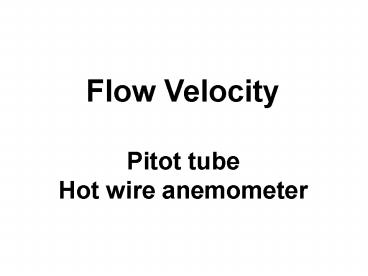Flow Velocity Pitot tube Hot wire anemometer PowerPoint PPT Presentation
1 / 26
Title: Flow Velocity Pitot tube Hot wire anemometer
1
Flow VelocityPitot tubeHot wire anemometer
2
Pitot tube
?V2/2
PT
PS
3
- At stagnation point we have V0
- PT stagnation pressure (total pressure)
- PS static pressure
- ???? fluid density
4
(PT-PS)
- hence
- measuring (pT - pS) V can be computed if ? is
given - Non-linear relationship
- Low sensitivity at low velocities
V
5
Pitot tube presents different pressure inlet in
particular one on the tip and some around the
sides
PT
PS
6
Common values for ?P (pT - pS ) ? ? 1.2 kg/m3 v
? 1 m/s v ? 10 m/s In air ?p is very
small Therefore the secondary differential
pressure transducer should have high sensitivity!
7
Dynamic behaviour V(t)????P(t)
Although mathematical representation allows for
good dynamic, differential pressure and piping
connection limit bandwidth Connection pipes
acts as lowpass filters
8
Fixing required for the Pitot probe is affected
by alignment uncertainty
A
-
V//
-
-
?
V ?
V
A
?
? 42.5
V ?
Positioning PS at ??? 40???45 misalignment
sensitivity ??can be decreased
9
Distance from the side can be an issue
D
Y
10
DISADVANTAGES
- Low frequency response
- Misorientation sensitive
- Affected by insertion errors(load effect acts on
the measurand due to velocity field deformation) - Highly sensitive to debris(e.g. ice formation if
used to compute aircraft speed)
11
Hot wireanemometer
12
- Measure V(t) up to high frequencies
- Very small
- Double design (null mode and deflection)
- Is an electric wire heated by a current I at a
voltage V up to a Tw temperature - Resistance?? RW ? RW I2 ? TW ?
- Flow V ? TW??
13
Hot wire PROBE
Hot wire L ? 1??3 mm d ? 5 ?m ??measuring
volume reduced but very fragile!
14
Film based versions exists for liquids (glass
support is required in this case)
Glass cylinder
Platinum film covering
Glass support
- Higher load effect
- Higher mechanical resistance
15
Measuring principles
Heat exchange between fluid and wire is a
function of fluid velocity Wire resistance?? RW
? RW I2 ? TW ? Flow rate V ? TW??
TW is kept constant by a
servo system acting on I Measuring System
I is kept constant while TW varies
16
Measuring principle
QIN RW I2 heat produced QOUT ????d
L(TW-TA) heat absorbed
RW wire resistance d wire diam. L wire
length TW wire temp. TA fluid
temperature ? coerced flow thermal exchange
coeff.
17
For a cylindrical wire we have ? ( A B Vn )
n ? 0.5 therefore QIN QOUT RW I2 ( A B
V n ) ? d L ( TW-TA )
18
- Each wire or film requires an ad hoc calibration
due to the fact that A, B, d, L, RW are different
and affected by uncertainty. - TW is not uniform, therefore difficult to
synthesize in a simple equation. - ?? each wire is calibrated individually in the
whole temperature range
19
Measuring principle
Therefore we have again the dual
configuration having I cost lead to ?V --gt
?RW ( and ?TW ) With TW cost ?V --gt ?I and
RW cost
20
Dynamic behaviour
RW I2 ( A B Vn ) ? d L( TW-TA )
Letting the temperature to change leads to a
first order measurement system ??constant
current configuration leads to a low frequency
range (200Hz) If TW is constant a higher cut-off
frequency can be achieved (up to 50kHz given we
can feed back fast enough the system...)
21
Measuring with constant current
I ??const input to a Wheatstone bridge
A variable resistance is used to compensate Rw up
to nulling E when v0 When v changes the bridge
gets unbalanced and its output is proportional to
v itself Wire gets hot!
R1
R
E
R1
Hot wire cables RW
22
Measuring with constant temperature
L
R1
R
e
A
C
E E1 Ae
L
R1
Offset E1
Hot wire
Output EAeE1 ? Negative feedback v?? TW?? RW??
E?? I?? TW?? TWcost Modifying L to match
implicit L and C a linear response up to fMAX?
50 kHz can be achieved.
23
Dynamic calibration and correction To perform a
dynamic calibration a square wave is forced onto
the hot wire and a response due to L and A is
given.. L and A can be easily modified
E
3 max
L
t
R1
R
?W
e
A
C
E
L
R1
24
Hot wire at a constant temperature allows for
fast measurements, therefore is the suggested
choice for turbulence measurement Allows for
spectral analysis of velocity
V(t)
t
25
Angular sensitivity Vefff (V,?) Hot wire
principle is sensitive to angular orientation of
the flow a custom calibration is required for
usage if ????0 Any misalignment leads to
uncertainty In case of unknown orientation two
wires can be used to assess it
?
V
26
DISADVANTAGES
- Hot wire is insensitive to flow direction
(positive vs negative) - High orientation sensitive
- Affected by insertion errors (load effect acts on
the measurand due to velocity field deformation) - Highly sensitive to electromagnetic noise(as
RTDs, TCs and strain gauges,it is in fact a very
good antenna)

